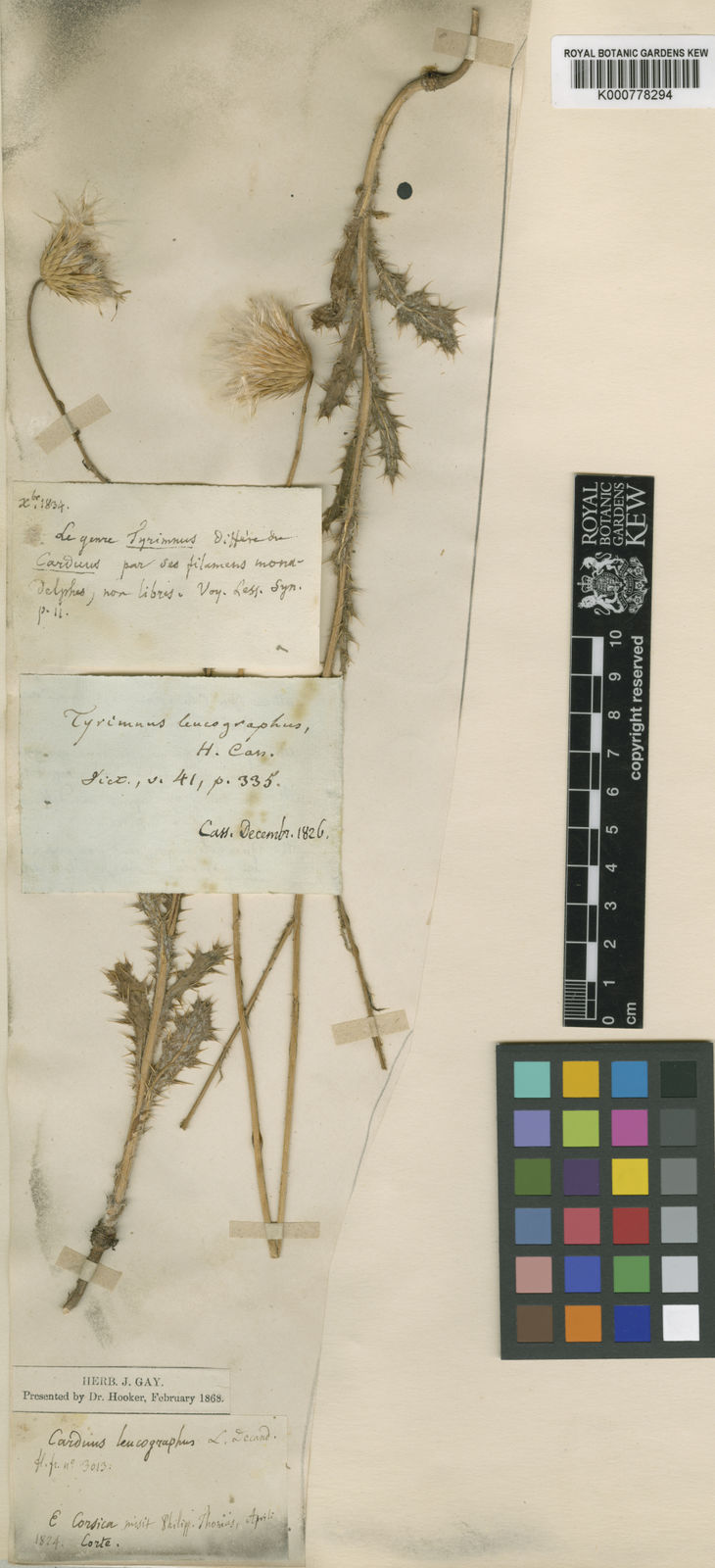Family: Asteraceae
Author: (L.) Cass.
Bibliography: F.Cuvier, Dict. Sci. Nat., ed. 2., ed. 2, 56: 207 (1828)
Year: 1828
Status: accepted
Rank: species
Genus: Tyrimnus
Vegetable: False
Observations: Medit.
Description
The White-spotted thistle, scientifically known as Tyrimnus leucographus, is a captivating member of the Asteraceae family. This thistle is distinctive for its striking appearance, marked by prominent white spots that adorn its foliage, offering a unique aesthetic to the plant world.
First documented by the renowned naturalist F. Cuvier in the second edition of the “Dictionary of Natural Sciences” in 1828, Tyrimnus leucographus has since piqued the interest of botanists and plant enthusiasts alike. The species was further characterized and named by (L.) Cass.
This thistle is predominantly found in Mediterranean regions, where it thrives in the warm climate and well-drained soils typical of this area. The White-spotted thistle is known not just for its ornamental value, but also for its resilience and adaptability to various environmental conditions within its native habitat.
Tyrimnus leucographus contributes to the biodiversity of the Mediterranean flora, playing a vital role in its ecosystem. Its presence supports various pollinators and provides an essential component of the local plant community structure.
Overall, the White-spotted thistle stands as a testament to the rich and diverse plant life found within the Mediterranean region, embodying both beauty and ecological significance.
Common Names
Deu: weißfleck-distel
Eng: white-spotted thistle
Swe: skrifttistel
En: White-spotted Thistle, Tyrimnus
Fr: Chardon à taches blanches, Tyrimne à taches blanches
De: Weißfleck-Distel, Bunte Distel
It: Cardo variegato
Sv: Skrifttistel
: White-spotted thistle
Synonyms
- Carduus leucographus (L.)
- Acarna leucographa ((L.) Hill)
- Tyrimnus leucographus var. cavillieri (Briq.)
- Cnicus leucographus ((L.) Roth)
Distribution
- Albania (native)
- Bulgaria (native)
- Corse (native)
- Cyprus (native)
- East Aegean Is. (native)
- France (native)
- Greece (native)
- Italy (native)
- Kriti (native)
- Lebanon-Syria (native)
- Libya (native)
- Sicilia (native)
- Spain (native)
- Turkey (native)
- Turkey-in-Europe (native)
- Yugoslavia (native)
Additional Images
Leaf
Taken Jun 17, 2017 by Yoan MARTIN (cc-by-sa)
Taken Apr 29, 2016 by Tela Botanica − Genevieve BOTTI (cc-by-sa)
Taken Mar 14, 2021 by Victoria Pérez (cc-by-sa)
Taken May 25, 2020 by Denis Bastianelli (cc-by-sa)
Taken Apr 25, 2019 by marina (cc-by-sa)
Taken Apr 29, 2021 by Pierre Bonnet (cc-by-sa)
Flower
Taken Sep 4, 2020 by Hendrik van Tilburg (cc-by-sa)
Taken May 16, 2017 by Jordan Galli (cc-by-sa)
Taken May 25, 2020 by Denis Bastianelli (cc-by-sa)
Taken May 22, 2018 by angel (cc-by-sa)
Taken May 16, 2017 by Jordan Galli (cc-by-sa)
Taken Jun 18, 2017 by Yoan MARTIN (cc-by-sa)
Taken Apr 29, 2021 by Pierre Bonnet (cc-by-sa)

© copyright of the Board of Trustees of the Royal Botanic Gardens, Kew.
Habit
Taken Mar 24, 2016 by Tela Botanica − Genevieve BOTTI (cc-by-sa)
Taken May 29, 2010 by Tela Botanica − Mathieu MENAND (cc-by-sa)
Taken Apr 29, 2021 by Pierre Bonnet (cc-by-sa)
Taken Jun 17, 2017 by Yoan MARTIN (cc-by-sa)
Taken Jun 17, 2017 by Yoan MARTIN (cc-by-sa)
Fruit
Taken Jun 17, 2017 by Yoan MARTIN (cc-by-sa)
Taken Jun 17, 2017 by Yoan MARTIN (cc-by-sa)
Taken Jun 17, 2017 by Yoan MARTIN (cc-by-sa)
Taken Jun 17, 2017 by Yoan MARTIN (cc-by-sa)
Taken May 25, 2020 by Denis Bastianelli (cc-by-sa)
Bark
Taken May 3, 2022 by jack et bea (cc-by-sa)
Taken May 15, 2020 by Catherine Perret (cc-by-sa)
Taken May 25, 2020 by Denis Bastianelli (cc-by-sa)
Other
Taken May 18, 2021 by allison blanchard (cc-by-sa)
Taken Apr 15, 2006 by Photoflora – Jean-Luc TASSET (©)
Taken May 15, 2012 by Photoflora – Benoit BOCK (©)
Taken Jan 1, 1970 by Photoflora – L’Abbé COSTE (©)
Sources
- WFO (No URL)
- IPNI (No URL)
- GBIF (https://www.gbif.org/species/3096551)
- POWO (http://powo.science.kew.org/taxon/urn:lsid:ipni.org:names:256981-1)
- PlantNet (https://identify.plantnet.org/species/the-plant-list/Tyrimnus leucographus (L.) Cass.)
Specifications
Growth
Ph maximum: 7.5
Ph minimum: 7.0
Light: 8
Atmospheric humidity: 3
Bloom months: [‘may’, ‘jun’, ‘jul’]
Soil nutriments: 7






























